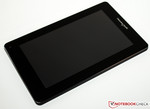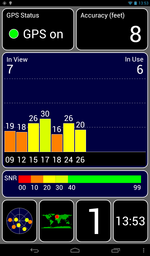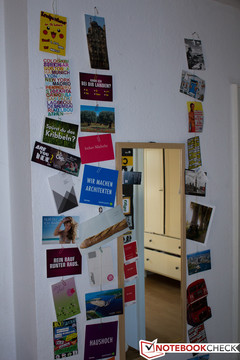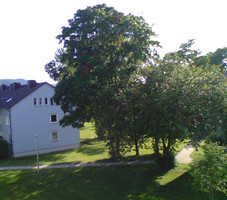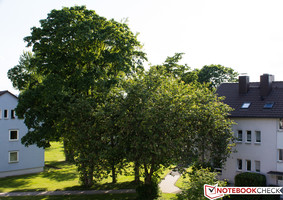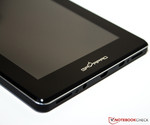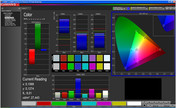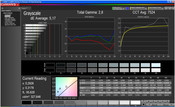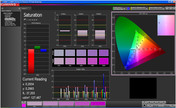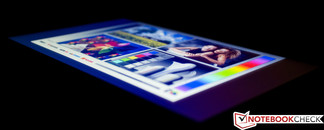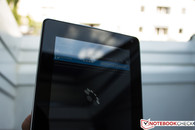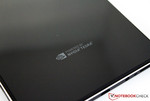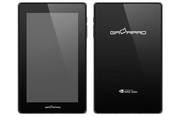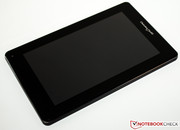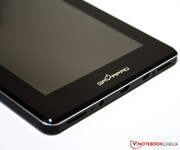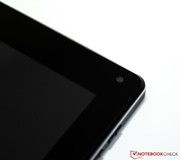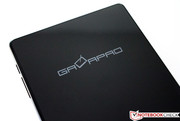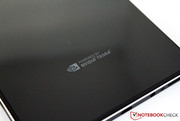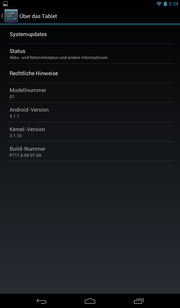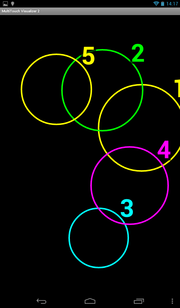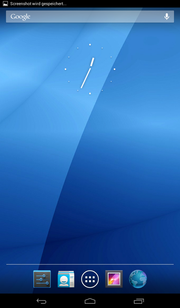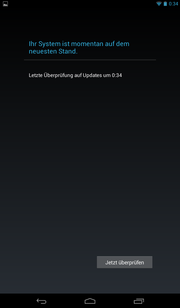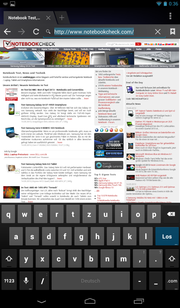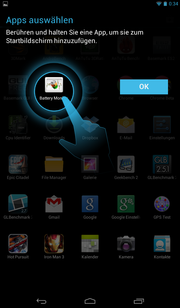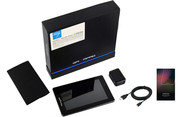Review Palit Galapad 7 Tablet

For the original German review, see here.
We've seen it often enough. An unknown manufacturer releases a new tablet with common hardware and few signs of innovation. The overall package is often disappointing, as the performance can be miserable and the software poorly implemented.
We admit that as the Galapad 7 was on its way to us but not yet in our hands, we regarded it with extreme prejudice. All the greater was our surprise. We knew the little tablet contained an nVidiaTegra 3 quad-core SoC at 1.3 GHz and 1024 MB RAM, but of course you can never tell from the specs what a tablet's manufacturing quality and tactile response will be like. Does the Android system, at a recommended price of 180 Euros (~$240), have more surprises in store and represent legitimate competition for the Google Nexus 7? You'll discover the answers here.
Case
As we already hinted in the introduction, the manufacturing quality of the Galapad 7's case is exceptional. The back of the device is reminiscent of the LG Google Nexus 4 and its glass cover. Upon looking closer, however, you see that our test device is made with shiny black plastic. As a result, the back yields easily to pressure and makes a quiet, discomforting sound. The tablet's frame is slightly raised on both the front and back and serves to protect the touchscreen and back cover. The sides of the device are made of black, matte aluminum with a silver accent.
At 196 x 122 x 9.9 mm (7.7 x 4.8 x 0.4 inches) and a weight of 320 grams (0.7 lbs), the Galapad 7 is about the same size as the Google Nexus 7 but a little bit lighter (by 25 grams).
Connectivity
In terms of features, buyers of the Google Nexus 7 have to make do with some cutbacks that are easy enough to handle. For example, it's not possible to expand the tablet's memory with a micro SD card and Google eliminated the webcam. Not true for the Galapad 7. The tablet comes with a plethora of connections and has all the common wireless modules necessary. There are no connections on the top side of the device or on the left. Two speakers are located on the bottom. In between, we see a 3.5 mm headphone jack, the micro USB port and a micro HDMI connection. The power button, volume rocker and micro SD slot (protected by a cover) sit on the right side.
Software
The Galapad runs the "pure form" of Android 4.1 (Jelly Bean) familiar from devices like the Google Nexus 4 or Nexus 7. The operating system isn't optimized for tablets but that doesn't hurt its functionality or handling - actually, quite the opposite. The manufacturer completely nixed the idea of adding bloatware or any other kind of system-customizing feature, leaving the vanilla operating system to maximize performance.
Communication & GPS
The GPS module has yet another surprise in store. The module is manufactured by Texas Instruments and bears the model name "WL1281". Even at a distance of three meters from a window, the GPS succeeds in making enough satellite connections to detect its position. This takes place within 30 seconds and positions us within an 8-foot radius of our exact location (App "GPS test"). Outdoors the GPS receiver is able to find more satellites and builds an even more stable signal.
The WLAN module transmits according to the standards 802.11 b/g/n in single-band mode and leaves no room for criticism. The connection is stable, and we didn't experience a single break over the entire course of our test. These days, nearly every mobile device supports Bluetooth, and the Galapad 7 is no exception. If you want to use the internet and aren't within the range of your home WLAN connection, you'll have to find a wireless hotspot as the model doesn't have a UMTS module. We don't have any information as to whether the manufacturer Galapad plans to release a model with a SIM card slot.
Cameras & Multimedia
The Galapad 7's main camera is its front camera. The tiny image sensor has a resolution of 2 megapixels and is mainly intended for video calls.
Wonders of course aren't to be expected of the camera's image quality. In poorly lit environments, the sensor expresses its disgruntlement with image noise. Due to its low resolution, the sensor can't reproduce images with a high degree of sharpness. Outdoors, the image noise mostly disappears but the lack of sharpness remains. Snapshots should only be taken with the Galapad 7 under extenuating circumstances.
Accessories & Warranty
The aesthetically pleasing packaging contains a micro USB cable, a modular charger, a paper quick-start guide and a cleaning cloth.
The manufacturer provides a 24-month warranty.
Input Devices & Operation
The 7-inch input device does its main task well. The touchscreen recognizes up to 10 fingers and executes multi-touch commands fluidly. We didn’t detect any differences between the Galapad 7's touchscreen and those installed in more expensive devices.
Display
In their eponymous tablet, Galapad installs a 7-inch IPS display with a resolution of 1024 x 600 pixels. Here we hoped that the manufacturer would provide a better resolution, as the Nexus 7 comes with a resolution of 1280 x 800 pixels. Our test device has a pixel density of 169.5 PPI (Nexus 7: 216 PPI).
With the X-Rite i1pro 2, we measured a maximum brightness of 354 cd/m² in the middle to the right side of the display. At 280.1 cd/m², the Nexus 7 screen is almost 50 cd/m² darker than the Galapad 7 display (331.6 cd/m²). The illumination is also slightly better at 89% which is pretty good for such a display. However, at 0.37 cd/m² and 881:1, both the Galapad's black value and contrast are lower than those of the Nexus 7.
| |||||||||||||||||||||||||
Brightness Distribution: 89 %
Center on Battery: 326 cd/m²
Contrast: 881:1 (Black: 0.37 cd/m²)
ΔE Greyscale Calman: 5.17 | ∀{0.09-98 Ø5}
Gamma: 2.8
CCT: 7524 K
The CalMAN measurements show that red tones are too pale, and the display is calibrated too far into the green. The DeltaE 2000 value of the color blue lies beyond the critical range, so blue tones are also too pale. If you look at the grayscale chart, you notice that only at 70% brightness do the colors start to deviate significantly from the ideal curve.
The combination of a good level of brightness and a contrast value of 881:1 make it possible for the Galapad 7 to display screen content reasonably well. The reflective touchscreen surface decreases the display's visibility, but with a little effort you can make it work.
Slowly but surely, IPS panels are starting to dominate the smartphone and tablet industry. We do sometimes still find lower-end devices without IPS displays - so we were all the more pleased that Galapad managed to install a screen with stable viewing angles.
Performance
Thanks to the large emblem on the backside of the device, you can easily see which SoC is at work in the Galapad 7. Even if the nVidia Tegra 3 belongs to the scrap heap at this point, its performance in the Galapad shouldn't be simply dismissed. The cores each have a clock rate of 1.3 GHz and 1024 MB of RAM for the software to use. Compared to the Nexus 7, the clock rate is up 100 MHz. Using synthetic and browser-based benchmarks, we looked closely for possible differences in performance between the competing devices.
The synthetic benchmarks show a clear trend. Thanks to its slightly higher clock rate, the Galapad performs well and surpasses the competition. Only in "Linpack for Android" do the tides turn and our test device comes in behind the competition.
| GLBenchmark 2.5 | |
| 1920x1080 Egypt HD Offscreen Fixed Time (sort by value) | |
| Palit Galapad 7 | |
| Google Nexus 7 | |
| Fujitsu Stylistic M702 | |
| Asus Memo Pad Smart 10 ME301T | |
| Egypt HD Fixed Time (sort by value) | |
| Palit Galapad 7 | |
| Google Nexus 7 | |
| Fujitsu Stylistic M702 | |
| Asus Memo Pad Smart 10 ME301T | |
| AnTuTu v3 - Total Score (sort by value) | |
| Palit Galapad 7 | |
| Google Nexus 7 | |
| Fujitsu Stylistic M702 | |
| Asus Memo Pad Smart 10 ME301T | |
| Basemark ES 2.0 - Taiji Free (sort by value) | |
| Palit Galapad 7 | |
| Google Nexus 7 | |
| HTC One X | |
| Fujitsu Stylistic M702 | |
| Asus Memo Pad Smart 10 ME301T | |
Just like in the synthetic benchmarks, the Galapad does exceptionally well in the browser-based tests. Our test device scores a maximum of 11% higher - no other device has a greater lead in any of the browser-based benchmarks. The Google Nexus 7 equipped with very similar hardware does up to 51% worse.
| Google V8 Ver. 7 - Google V8 Ver. 7 Score (sort by value) | |
| Palit Galapad 7 | |
| Google Nexus 7 | |
| HTC One X | |
| Fujitsu Stylistic M702 | |
| Asus Memo Pad Smart 10 ME301T | |
| Browsermark - --- (sort by value) | |
| Palit Galapad 7 | |
| Google Nexus 7 | |
| Fujitsu Stylistic M702 | |
| Asus Memo Pad Smart 10 ME301T | |
| Sunspider - 0.9.1 Total Score (sort by value) | |
| Palit Galapad 7 | |
| Google Nexus 7 | |
| HTC One X | |
| Fujitsu Stylistic M702 | |
| Asus Memo Pad Smart 10 ME301T | |
| Octane V1 - Total Score (sort by value) | |
| Palit Galapad 7 | |
| Google Nexus 7 | |
| Fujitsu Stylistic M702 | |
| Asus Memo Pad Smart 10 ME301T | |
* ... smaller is better
We rate the flash memory's performance with the "AndroBench 3" app. Here the results are mixed - in the reading tests the Galapad achieves good results and in some cases speeds considerably far ahead of other devices but we see the opposite phenomenon in the write tests.
| AndroBench 3-5 | |
| Sequential Read 256KB (sort by value) | |
| Palit Galapad 7 | |
| Google Nexus 7 | |
| Fujitsu Stylistic M702 | |
| Asus Memo Pad Smart 10 ME301T | |
| Sequential Write 256KB (sort by value) | |
| Palit Galapad 7 | |
| Google Nexus 7 | |
| Fujitsu Stylistic M702 | |
| Asus Memo Pad Smart 10 ME301T | |
| Random Read 4KB (sort by value) | |
| Palit Galapad 7 | |
| Google Nexus 7 | |
| Fujitsu Stylistic M702 | |
| Asus Memo Pad Smart 10 ME301T | |
| Random Write 4KB (sort by value) | |
| Palit Galapad 7 | |
| Google Nexus 7 | |
| Fujitsu Stylistic M702 | |
| Asus Memo Pad Smart 10 ME301T | |
Videos & Games
We have no concerns to report in the multimedia section of this review. Our demands of the Galapad 7 are fully met as it plays videos in Full HD quality without a problem. We tested this using various trailers from the latest movies. The data throughput of the MKC container files reaches up to 6100 kBit/s.
We tested the tablet's gaming abilities with various apps from the Google Play store. Our tests included 3D games like "Need for Speed" and "GTA III". The Tegra 3 processor has enough performance reserves at its command to display everything fluidly. It follows, of course, that the tablet has no problem running 2D games like "Angry Birds" or "Cut the Rope".
Emissions
Temperature
When it comes to temperature, the manufacturer does everything right. The device never gets uncomfortably warm and it remains cooler than the Nexus 7 under low loads. Under load, we measure an average temperature of 35.5°C (95.9°F) on the front and 32.8°C (91°F) on the back side. If the SoC goes into idle mode, the temperatures drop by about 5°C (9°F). We measure an average temperature of 30.2°C (86.4°F) on the front and only 27.9°C (82.2°F) on the back. The highest temperature is produced by the power supply at 45.7°C (114.3°F). With those numbers, the temperatures remain within a perfectly safe range.
(±) The maximum temperature on the upper side is 43.8 °C / 111 F, compared to the average of 33.7 °C / 93 F, ranging from 20.7 to 53.2 °C for the class Tablet.
(±) The bottom heats up to a maximum of 41.5 °C / 107 F, compared to the average of 33.2 °C / 92 F
(+) In idle usage, the average temperature for the upper side is 30.2 °C / 86 F, compared to the device average of 30 °C / 86 F.
Speakers
The Galapad 7 houses two speakers. These flank the micro HDMI and micro USB ports. Unfortunately, our hitherto good impression of the tablet is a little tarnished by the speakers. We've reviewed devices with one speaker that achieved better results. The sound is dull and tinny even at low volumes. Additionally, starting at around 60% of the maximum volume the speakers become overloaded. There can be no talk of a full-bodied sound here.
Energy Management
If the SoC has no load to shoulder, the tablet's power draw lies between 1.6 and 3 W. Compared with the Samsung Galaxy Note 8.0, the Galapad's energy use is similar, as the Note 8.0's display is somewhat larger. If the Galapad 7's Tegra 3 has a ton of work to tackle, it pulls between 5.3 and 6.8 W. The Note 8.0 uses more energy here as well. For a 7-inch tablet, the various power consumption rates are in the normal range. Now the battery has to show us its efficiency.
| Off / Standby | |
| Idle | |
| Load |
|
Key:
min: | |
Battery Life
The battery has a capacity of 3500 mAh and can't be switched out. We simulate a maximum-load scenario with the help of the "Stability Test" app. During this test, the display brightness is set to the maximum and all the wireless modules are activated. After 2 hours and 36 minutes, the tablet needs to be hooked up to the power supply. The Nexus 7 runs out of steam 14 minutes earlier. We determine the maximum battery run time at the lowest brightness setting and with the wireless modules deactivated. The Galapad doesn't execute any actions and runs for 10 hours and 24 minutes. Between the two extremes we have the WLAN surf test. In this test the display brightness is set to 150 cd/m² (about 55%) and a script loads a new webpage at 40 second intervals. After 6 hours and 50 minutes our test device calls it quits. The battery needs 02:39 hours on a power socket to fully recharge.
Verdict
At first, we expected little of the Galapad 7 but as soon as we had it in our hands, we were surprised at the quality of the product. Its performance, thanks to the NVIDIA Tegra 3, is also satisfactory. One point of criticism is the display resolution as the competitor from Google, for example, impresses us with a higher pixel density. In a tablet, a battery with a capacity of 3500 mAh isn't going to be able to reach dazzling battery run times. Our battery endurance tests confirm that assessment.
But the Galapad 7's price-performance ratio is still persuasive. The tablet is currently available in online stores for about 180 Euros (~$240). The mobile companion fulfills its tasks well but as with the majority of our test devices, there's potential for improvement. If you're looking to venture into the tablet world but aren't prepared to invest enormous sums of money, we do believe Galapad's Galapad 7 is worth your consideration.




